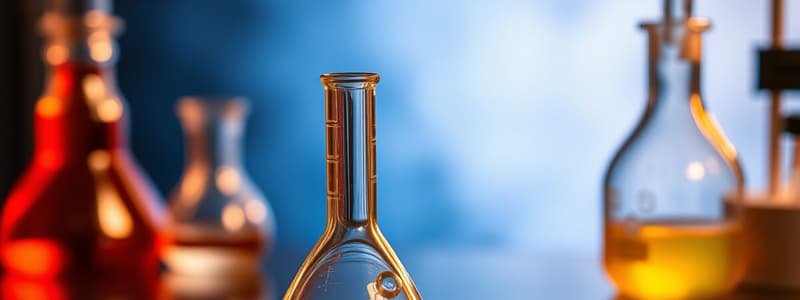Podcast
Questions and Answers
Which process describes two or more reactants combining to form a single product?
Which process describes two or more reactants combining to form a single product?
- Synthesis Reaction (correct)
- Double Displacement Reaction
- Decomposition Reaction
- Single Displacement Reaction
Which of the following is an example of a double displacement reaction?
Which of the following is an example of a double displacement reaction?
- Na₂S + BaCl₂ → 2NaCl + BaS (correct)
- Zn + CuSO₄ → ZnSO₄ + Cu
- 2H₂O → 2H₂ + O₂
- 2H₂ + O₂ → 2H₂O
What does the law of conservation of mass state?
What does the law of conservation of mass state?
- Mass is transformed into energy during a reaction.
- The total mass of reactants equals the total mass of products. (correct)
- Mass can be created in a chemical reaction.
- The total mass of reactants is greater than the total mass of products.
Which factor does NOT typically increase the rate of a chemical reaction?
Which factor does NOT typically increase the rate of a chemical reaction?
Which type of reaction involves a single compound breaking down into two or more products?
Which type of reaction involves a single compound breaking down into two or more products?
Which statement accurately describes single displacement reactions?
Which statement accurately describes single displacement reactions?
Which of the following applications is based on the principles of chemical combination?
Which of the following applications is based on the principles of chemical combination?
What is the general form of a synthesis reaction?
What is the general form of a synthesis reaction?
Flashcards are hidden until you start studying
Study Notes
Chemical Combination
Definition
- Chemical combination refers to the process by which two or more substances (elements or compounds) interact to form new substances.
Types of Chemical Combination
-
Synthesis Reaction
- Two or more reactants combine to form a single product.
- General form: A + B → AB
- Example: 2H₂ + O₂ → 2H₂O
-
Decomposition Reaction
- A single compound breaks down into two or more products.
- General form: AB → A + B
- Example: 2H₂O → 2H₂ + O₂
-
Single Displacement Reaction
- An element displaces another in a compound.
- General form: A + BC → AC + B
- Example: Zn + CuSO₄ → ZnSO₄ + Cu
-
Double Displacement Reaction
- The exchange of ions between two compounds to form two new compounds.
- General form: AB + CD → AD + CB
- Example: Na₂S + BaCl₂ → 2NaCl + BaS
Law of Conservation of Mass
- Mass is neither created nor destroyed in a chemical reaction.
- The total mass of reactants equals the total mass of products.
Factors Affecting Chemical Combination
- Concentration: Higher concentration of reactants increases the rate of reaction.
- Temperature: Increased temperature typically increases reaction rates.
- Surface Area: Greater surface area of solid reactants enhances reaction rates.
- Catalysts: Substances that speed up reactions without being consumed.
Importance of Chemical Combination
- Fundamental for understanding chemical reactions and processes.
- Essential in industrial applications, synthesis of materials, and biochemical reactions.
Applications
- Pharmaceuticals: Drug synthesis and formulation.
- Materials Science: Creation of alloys and polymers.
- Environmental Chemistry: Combustion reactions and pollution control.
Definition
- Chemical combination is the interaction of two or more substances to produce new substances.
Types of Chemical Combination
-
Synthesis Reaction
- Combines two or more reactants into a single product.
- General form: A + B → AB
- Example: Formation of water from hydrogen and oxygen: 2H₂ + O₂ → 2H₂O.
-
Decomposition Reaction
- A single compound breaks down into two or more products.
- General form: AB → A + B
- Example: Electrolysis of water produces hydrogen and oxygen: 2H₂O → 2H₂ + O₂.
-
Single Displacement Reaction
- An element replaces another element in a compound.
- General form: A + BC → AC + B
- Example: Zinc displacing copper in copper sulfate: Zn + CuSO₄ → ZnSO₄ + Cu.
-
Double Displacement Reaction
- Exchange of ions between two compounds resulting in two new compounds.
- General form: AB + CD → AD + CB
- Example: Sodium sulfide and barium chloride reacting to form sodium chloride and barium sulfide: Na₂S + BaCl₂ → 2NaCl + BaS.
Law of Conservation of Mass
- In any chemical reaction, mass is neither created nor destroyed.
- The total mass of reactants must equal the total mass of products.
Factors Affecting Chemical Combination
- Concentration: Higher concentrations of reactants can lead to increased reaction rates.
- Temperature: Raising the temperature generally accelerates reactions.
- Surface Area: Increasing the surface area of solid reactants can enhance the rate of reaction.
- Catalysts: Substances that increase reaction speeds without being consumed in the reaction.
Importance of Chemical Combination
- Understanding chemical combinations is critical for chemistry and related fields.
- Key in industrial applications, synthesis of new materials, and understanding biochemical processes.
Applications
- Pharmaceuticals: Crucial for drug development and formulation.
- Materials Science: Involves the creation of alloys and polymers.
- Environmental Chemistry: Relevant in combustion reactions and efforts to control pollution.
Studying That Suits You
Use AI to generate personalized quizzes and flashcards to suit your learning preferences.




